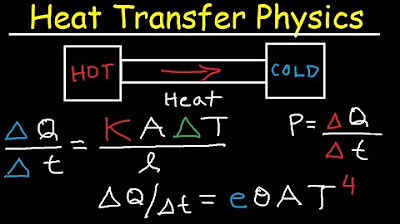Understanding Thermal Radiation
Summary
TLDRThis video explains the fundamental concepts of thermal radiation, including its role in heat transfer through electromagnetic waves. It covers key principles like the Stefan-Boltzmann law, Wien's displacement law, and the emissivity of real objects compared to ideal black bodies. The video also explores how radiation behaves in different materials and surfaces, with practical applications in engineering, such as in photovoltaic cells and heat exchangers. A segment also touches on the quantum theory of radiation, highlighting the contributions of Max Planck and the rise of quantum mechanics. The video is sponsored by CuriosityStream, offering further resources on quantum history.
Takeaways
- 😀 Thermal radiation is the emission of electromagnetic waves from any object with a temperature above absolute zero, and it occurs without the need for a medium.
- 😀 Thermal radiation, along with conduction and convection, is one of the three methods of heat transfer.
- 😀 Electromagnetic waves, which carry thermal radiation, travel in a straight line at the speed of light and can even pass through a vacuum.
- 😀 The total energy radiated by an object per second per unit area is called emissive power and is measured in Watts per square meter.
- 😀 A black body is an idealized object that emits the maximum amount of thermal radiation for a given temperature. Its emissive power can be calculated using the Stefan-Boltzmann law.
- 😀 According to the Stefan-Boltzmann law, the amount of energy radiated by a body increases exponentially as its temperature rises.
- 😀 The wavelength at which most thermal radiation is emitted depends on the object's temperature and can be calculated using Wien's displacement law.
- 😀 Real bodies behave differently from ideal black bodies, with their emissivity (the ability to emit radiation) being less than that of a black body.
- 😀 Emissivity, absorptivity, reflectivity, and transmissivity describe how a body interacts with thermal radiation, and these parameters vary depending on the material and surface finish.
- 😀 The interaction between two surfaces exchanging radiation depends on their relative positioning, and the view factor defines how much radiation from one surface reaches the other.
- 😀 Classical physics' understanding of radiation was flawed due to the ultraviolet catastrophe, but Max Planck's introduction of quantized energy packets (photons) led to the development of quantum mechanics.
Q & A
What is thermal radiation, and how does it differ from other heat transfer methods?
-Thermal radiation is the emission of electromagnetic waves by objects with a temperature above absolute zero. Unlike conduction and convection, which require a medium, thermal radiation can occur in a vacuum, allowing heat to transfer across space.
What role does wavelength play in thermal radiation?
-The wavelength of thermal radiation is typically between 0.1 and 100 microns, encompassing the UV, visible, and infrared spectra. The wavelength determines the type of electromagnetic waves emitted, with different objects emitting radiation at varying wavelengths depending on their temperature.
What is a black body in the context of thermal radiation?
-A black body is an idealized object that absorbs and emits the maximum amount of thermal radiation for a given temperature. It serves as a reference for calculating emissive power, which can be described by the Stefan-Boltzmann law.
How does the Stefan-Boltzmann law relate to emissive power?
-The Stefan-Boltzmann law states that the emissive power of a black body is proportional to the fourth power of its absolute temperature. This means that as the temperature increases, the emitted radiation grows exponentially.
Why do objects glow at high temperatures, and how is this related to Wien’s displacement law?
-As the temperature of an object increases, the wavelength at which it emits the most radiation shifts to shorter wavelengths, eventually entering the visible spectrum. Wien's displacement law describes this shift, explaining why heated objects begin to glow.
How is emissivity different for real objects compared to a black body?
-Emissivity is a measure of how much thermal radiation a real object emits compared to a black body at the same temperature. Real objects emit less radiation, and their emissivity varies with temperature and wavelength.
What is the significance of absorptivity, reflectivity, and transmissivity in thermal radiation?
-These properties describe how an object interacts with incident radiation. Absorptivity is the fraction of radiation absorbed, reflectivity is the fraction reflected, and transmissivity is the fraction transmitted through the material. These values depend on the surface material and finish.
What is a view factor, and why is it important in heat transfer?
-A view factor is a geometric parameter that quantifies the fraction of radiation emitted from one surface that reaches another surface. It is crucial for calculating the net heat transfer between surfaces.
How do engineers use thermal radiation in practical applications?
-Engineers model thermal radiation to design energy-efficient systems like photovoltaic cells, heat exchangers, and buildings. By adjusting materials and surface finishes, they can control how much heat is radiated or absorbed, optimizing energy use.
What is the connection between thermal radiation and quantum mechanics?
-The study of thermal radiation led to the discovery that radiation is emitted in discrete packets of energy, called photons, rather than continuously. This breakthrough by Max Planck helped develop quantum mechanics, which revolutionized our understanding of physics.
Outlines

此内容仅限付费用户访问。 请升级后访问。
立即升级Mindmap

此内容仅限付费用户访问。 请升级后访问。
立即升级Keywords

此内容仅限付费用户访问。 请升级后访问。
立即升级Highlights

此内容仅限付费用户访问。 请升级后访问。
立即升级Transcripts

此内容仅限付费用户访问。 请升级后访问。
立即升级浏览更多相关视频

Thermal Conductivity, Stefan Boltzmann Law, Heat Transfer, Conduction, Convecton, Radiation, Physics

Heat Transfer – Conduction, Convection and Radiation

Heat Transfer - Conduction, Convection, and Radiation

Thermal energy, temperature, and heat | Khan Academy

KALOR DAN PERPINDAHAN KALOR SERTA CONTOH SOAL DAN PENYELESAIANNYA|| Kelas XI SMA || Gasal

Electromagnetic Waves
5.0 / 5 (0 votes)
